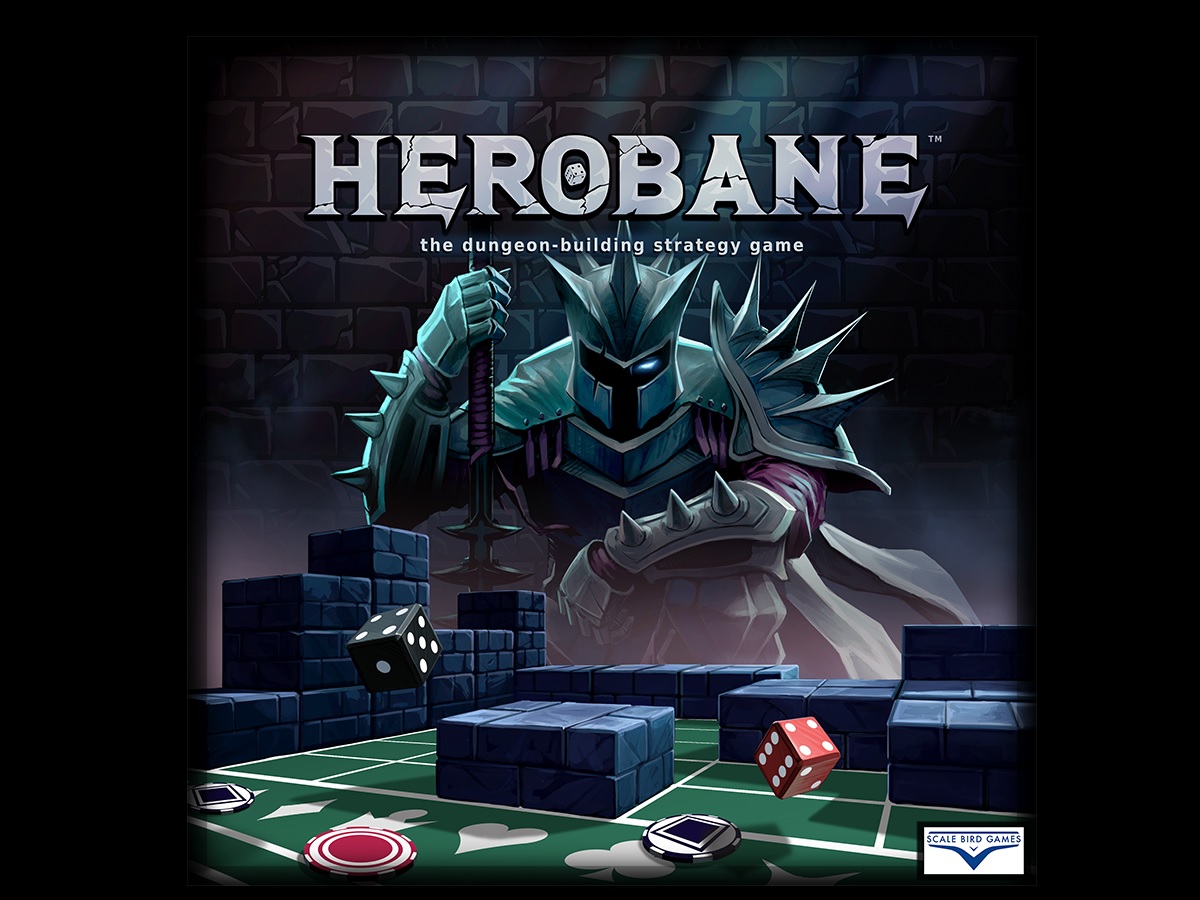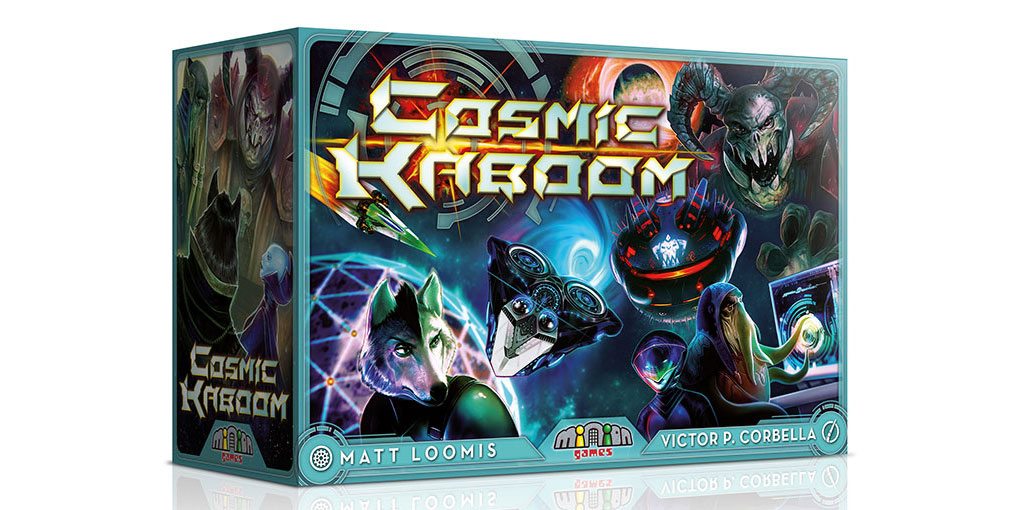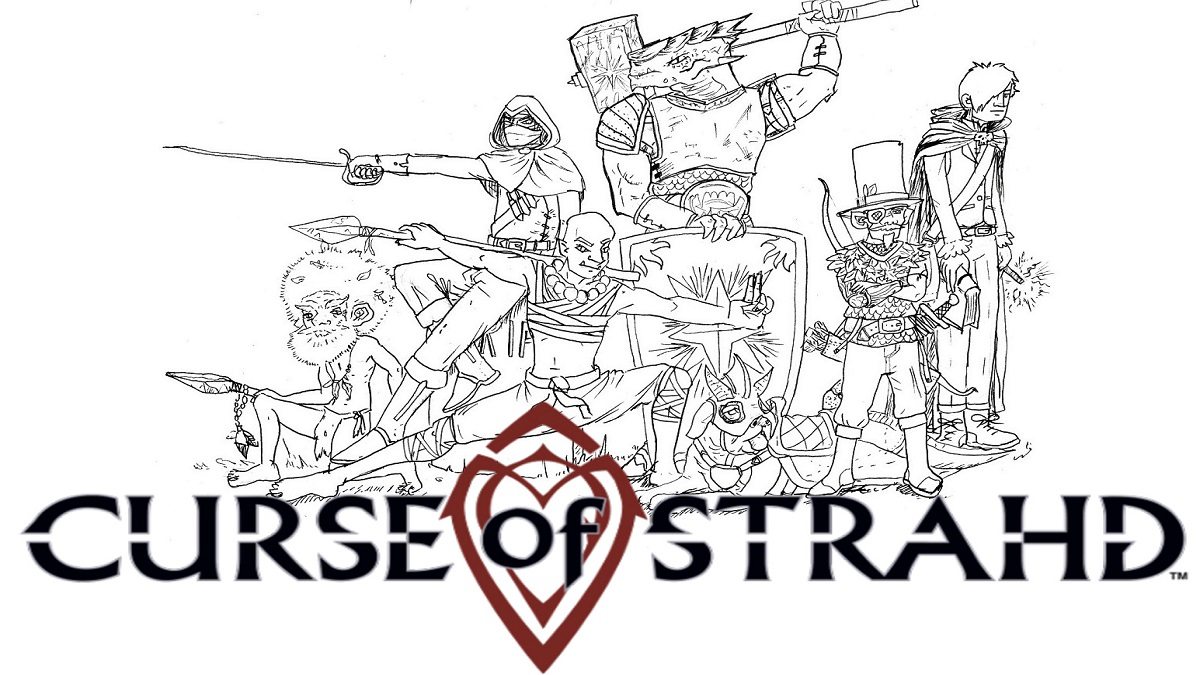There are many games where players delve into dungeons, fight dangerous creatures, and steal the treasure. They can be a lot of fun, but what about those who control those dungeons? Now you can build up your own dungeon, recruit minions to do your fighting, and then lure brave heroes into your domain where you can defeat them one at a time.
What Is Herobane?
Herobane is a game for 2-4 players, ages 13 and up, and takes about 45-60 minutes to play. It’s currently seeking funding on Kickstarter, with a pledge level of $40 for a copy of the game. Players take on the role of dungeon keepers who must improve their dungeons, collect resources, hire minions, and challenge daring heroes to grow their infamy. Herobane was designed by Sam Burley and Eli Shiffrin, published by Scale Bird Games, with illustrations by Sam Burley.
New to Kickstarter? Check out our crowdfunding primer.
Herobane Components
Note: My review is based on a prototype copy, so it is subject to change and may not reflect final component quality.
Here is what you get with the game:
- 4 Dungeon boards
- 108 Dungeon cards
- 54 Hero cards
- 111 Resource chips
- 90 Dungeon tiles
- 16 Combat dice
- 2 Resource dice
- 1 Rulebook
- 1 Plastic Tray

Each player has their own dungeon board which lists the name of their avatar and its abilities. The dungeon is represented by a 36 spaces arranged in six rows of six. Each space shows a symbol with 2 red circles, 2 black circles, or one of each. These represent the magic (red) and might (black) resources you get when that space is selected during a roll of the resource dice. Players can purchase new types of rooms to upgrade their dungeon and increase the amount of resources provided by that space. There are spaces at the top and bottom of the board to show where players keep their pool of resource chips and those chips they can spend.

Dungeon cards come in three different types: room, minion, and gambit. Room cards allow players to purchase room tiles to upgrade their dungeon. Some also provide abilities which can be used during play. Minion cards are creatures you can hire and use to fight against heroes that come into your dungeon. Gambit cards come in a variety of types. Some are curses you can place on opponent’s dungeons. Others are boons you can use to modify your minions to make them more powerful. Skills can provide additional damage during combat such as Fireball. Dungeon cards are drawn from the dungeon deck and kept in players’ hands until they are used. Dungeon cards have a cost in order to play them which is shown in the top left corner of the card. Magic cards cost red tokens, might cards cost black tokens, and wild cards can be paid for with a combination of the two colors of tokens.
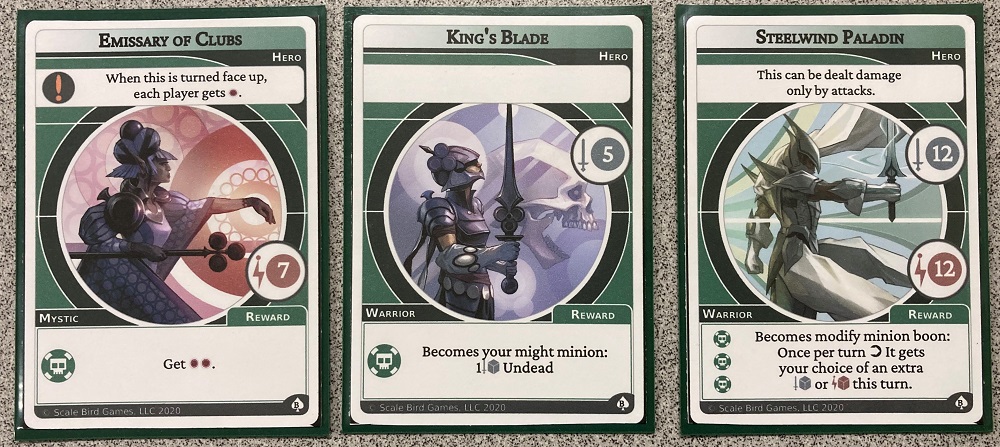
Hero cards represent the heroes who are seeking to infiltrate your dungeon and steal your treasure (resources). Any abilities are listed at the top of the card. Along the right side is one or two numbers that represent damage thresholds for might or magic attacks. Some have both thresholds. The rewards for defeating the hero are listed at the bottom of the card. Within the hero deck are 15 epic heroes. These are more powerful than other heroes and offer the only way to earn victory points which are needed to win the game.
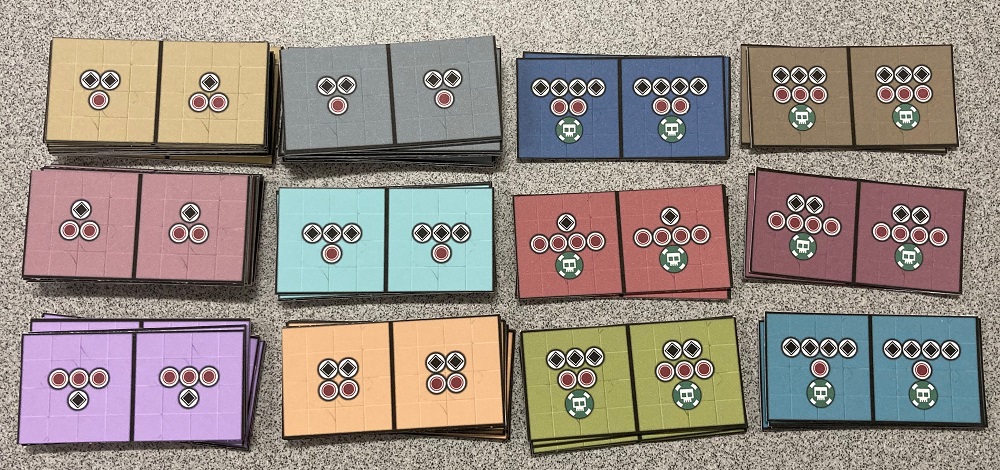
After paying to play a dungeon room card, players collect the dungeon tiles listed on the card and can place them on their dungeon boards. Unless otherwise noted, all of the dungeon tiles must be placed so they are touching one another. Dungeon tiles can be placed over the top of other dungeon tiles, but not under them. Dungeon tiles provide more resources than the default spaces on the dungeon board, so it is important to upgrade your dungeon as much as you can. Some dungeon tiles also provide reputation chips as well as might and magic chips.
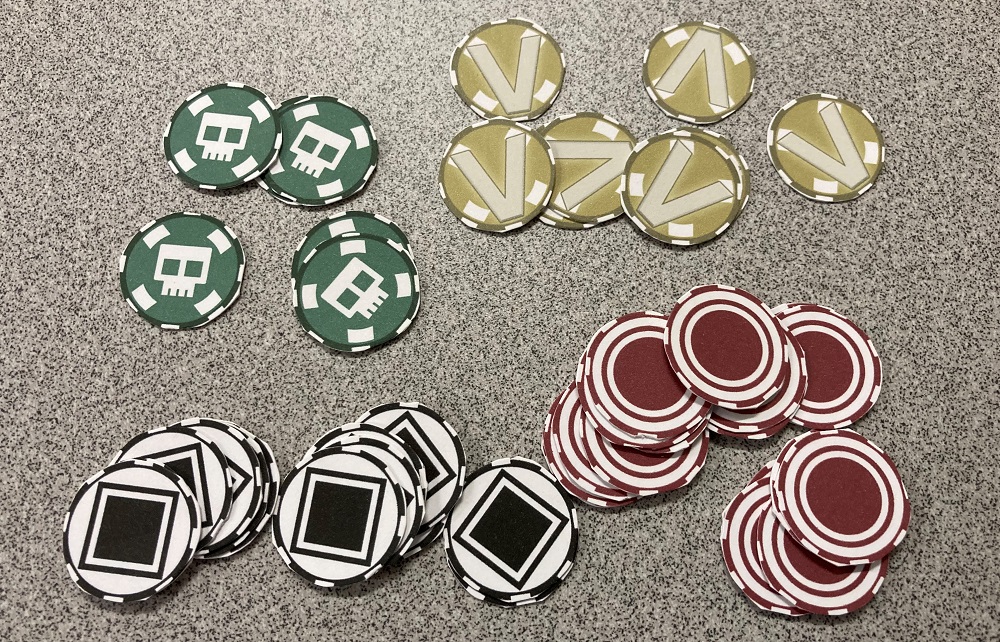
Resource chips are used by players to pay for playing dungeon cards. Black chips represent might, red chips are magic, and the green chips with the skull are reputation. You will need reputation chips in order to purchase victory point chips which are needed to win the game.
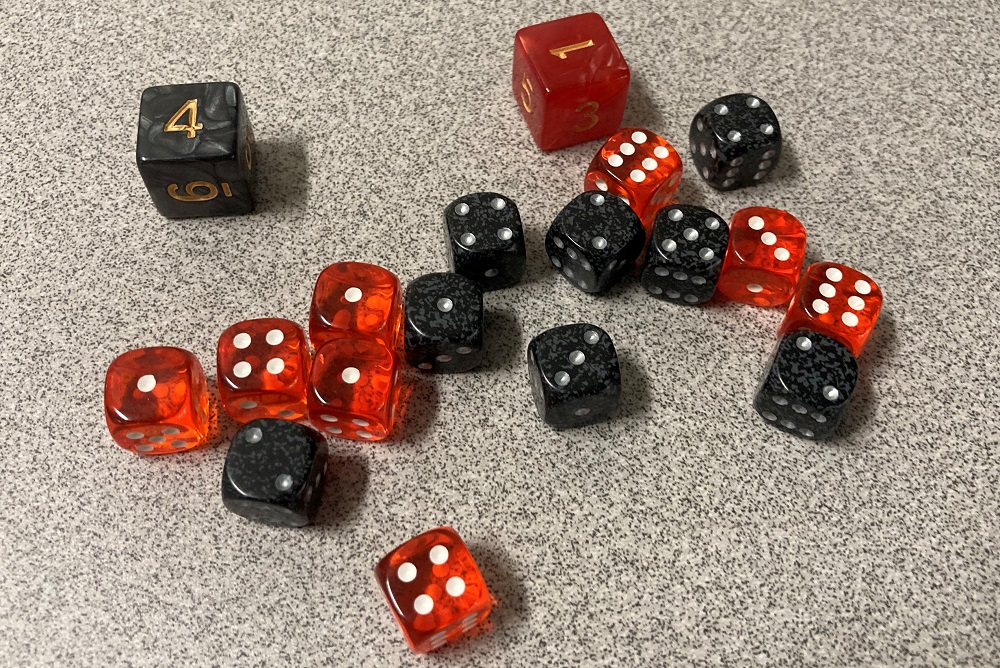
Herobane uses two different types of dice. The two larger dice with numbers printed on them are the resource dice. They are rolled and the results are compared to the players’ dungeon boards to determine what resources they collect. The back die determines the column and the red die the row. The smaller dice are combat dice which are used during combat. Red dice are used for magic attacks and black dice for might attacks.
How to Play Herobane
You can view the rules here.
The Goal
The goal of the game is be the first player to collect the required number of victory points by defeating epic heroes. This number depends on the number of players and whether you are playing a short, standard, or long game.
Setup
When starting a game, each player rolls a die to determine the starting player. The starting player then chooses one of the dungeon boards with the other players choosing as they go around the table. Each player then takes 8 black might chips, 8 red magic chips, and 8 green reputation chips and places them at the top of their dungeon board in the chip bank area to be used later.
Next arrange the dungeon tiles into piles of like colors so they are in easy reach of all the players along with the dice and victory point chips. Shuffle the dungeon cards into one pile and the hero cards into a second pile.
Beginning with the starting player, each player draws three cards from the dungeon deck. Finally, draw the first five cards from the hero deck and place them face up in a line to create the hero row.

Gameplay
Herobane is played in turns with each player completing a turn and then play passing to the next player. Each turn is divided into a start, action, and end phases.
Start of Turn
At the start of each player’s turn, check for start of turn abilities on the hero cards in the hero row or on the cards in front of them. The player then draws three cards from the dungeon deck. Next, they roll the resource die and collect their resources as shown on the dungeon board. The next player in the turn order also collects resources using the same dice roll, but using their own dungeon board.
Turn Actions
During this phase of the turn, the player may take any number of actions in any order and any number of times. There are six different actions.
At any time during a turn, a player may discard two cards from their hand and exchange them for their choice of either a red or black chip.

Players can play a minion, gambit, or room card from their hand. First they must pay the cost of the card in resource chips. If its a minion card, put it in front of the player. It can attack heroes and curses starting this turn. If its a gambit card, put it into the dungeon deck’s discard pile, then perform its action. If it is a boon, place it under a minion it will affect or if a curse, place it in front of another player’s dungeon board. If a player plays a room card, put the card next to your dungeon face up and take the dungeon tiles listed on the card. Place them on your dungeon’s grid of spaces. Tiles must be placed contiguously. They can be placed over other tiles, but must be placed completely over an existing tile and not over only part of a tile.

Players can use an ability of their avatar listed on their dungeon board or abilities listed on cards they have in play. These can include minion and room cards. Some heroes when defeated may provide abilities you can use as well.
If there is no hero in your dungeon, you may lure one into your dungeon. Select any hero card in the hero row and place it in front of you. Do not replace it in the hero row. This hero remains in front of the player until defeated or until the end of the turn. You can only have one hero in front of you at a time. However, once a hero is defeated, you could lure another hero into your dungeon during the same turn.
The last two actions a player may take is to attack a hero and then to resolve an attack. These are described in greater detail in the section covering combat.
End of Turn
Once a player has taken all the actions they wish to do, the end phase begins. If a hero remains in your dungeon, resolve any remaining attacks and then discard the hero card. Now roll the resource die and instead of gaining resources, you lose the resources determined by the roll. If you can’t pay all of the cost, pay as much as you can. You only pay this penalty if a hero is in your dungeon during this phase. Next, if you have more than five minions remaining in front of you, discard them until you have only five. Now if you have more than eight cards in your hand, discard down to eight. (Before you get to the end of turn, check the number of cards in your hand and discard them for resources.) Finally, discard the oldest hero from the hero row (the one that has been out the longest) and then refill the row back up to five heroes. Now it is the turn of the next player.
Combat
Combat in Herobane is a bit different than other games. There are two main parts: starting an attack and then resolving an attack. It is important to realize that they don’t have to occur consecutively.
When you start an attack, choose a minion and then select what it is attacking. It could be a hero in your dungeon or a curse another player has placed on your dungeon. Check for any abilities that occur when it attacks. Now roll the appropriate number of combat dice. Might minions roll only black dice. Magic minions roll only red dice. Wild minions roll both red and black dice. The number of dice they roll is listed on their card. Place the rolled dice on top of or above the minion card.

Before you resolve the attack, you can now perform other actions with the exception that another minion can’t attack while a minion is already attacking. You can play a card or ability that lets you re-roll combat dice. You could also play a gambit card that inflicts more damage on the hero. Some room cards or minion cards have an ability you can choose to use at this time.
In order to resolve an attack, the dice rolled now become damage marked on the hero or curse. Compare the damage inflicted with the damage threshold of the target being attacked. If a gambit alone is used to deal lethal damage, the hero or curse is defeated without needing a minion to attack. If a curse is attacked and the damage equals or exceeds the threshold, it is discarded. If the damage does not meet the threshold, the damage stays on the curse card and the attacking minion survives.
When fighting against a hero, there are three possible outcomes. If the hero has been dealt might and magic damage equal to or greater than its damage threshold, it is defeated. Your minion survives. Claim the hero’s rewards and put the hero card next to your dungeon face up. If the hero has been dealt lethal damage to either might or magic, but not both, the hero is stunned. Both the hero and minion survive. Stunning can only happen the first time a threshold is met. Stunning then wears off prior to the next attack. If the hero has not been dealt lethal damage, the hero survives and your minion is defeated. Discard your minion.

If the hero survives, any damage remains on it until the end of the turn. Another minion can then attack it. Minions can only attack once per turn. You may want to rotate a minion card 90 degrees to show that it has attacked during that turn.
Game End
The game ends immediately when a player has the required number of victory points for a win. In a short game, players need to get 3 victory points for a two player game or 2 victory points for game with 3 or more players. Standard games requires 5 and 3 victory points respectively while long games need 8 and 5 victory points.
The only way to get victory points is to defeat epic heroes. There are 15 in the hero deck. Once one is defeated, its reward allows you to exchange reputation chips for victory points: usually four reputation for one victory point or six reputation for two victory points depending on the epic hero. Therefore, before you take on an epic hero, make sure you have enough reputation to trade for victory points.
The game also ends when the 15th epic hero is defeated. In that case, the player with the most victory points is the winner. Ties are broken by how many heroes each player has defeated.
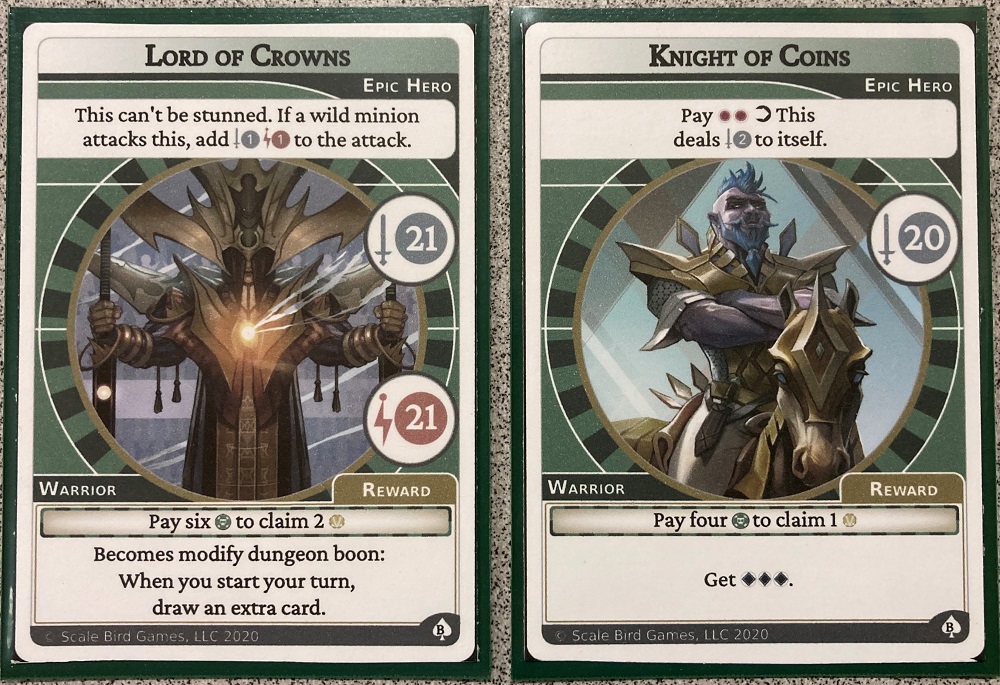
Why You Should Play Herobane
While Herobane may have some mechanics similar to other games, the way it puts it all together makes this a unique game. Rolling for resources definitely adds an element of chance. However, the ability to customize your dungeon by playing room cards and placing dungeon tiles is a very important part of the game. If you want to be able to afford the more powerful minions, you need to be raking in resources each turn rather than settling for only two chips. Plus if you can get those rooms that provide reputation chips, you can focus on going after epic heroes sooner. Some cards take advantage of filling up your dungeon with rooms. For example, the Gold-Scale Dragon inflicts an additional might and magic damage for every three rows of your dungeon that are filled. Also, since you can never have more than eight chips of each type in your bank, you want to be sure to spend your resources so you have room to receive more on your next turn.

As you are building up your dungeon, you also need to begin hiring minions so you can take on heroes and get some reputation. At the start, you will not be able to afford some of the more powerful minions. However, some are definitely worth saving up for such as the Frostflux which rolls two dice of each color. However, its ability allows you to change one of its dice to the other color. This makes this minion great for taking on either might or magic heroes. Some minions will just be cannon fodder, but you still need them when going after epic heroes. Though you can only have 5 minions in front of you at the end of your turn, you can have more than that during the turn. This lets you play some expendable minions to weaken powerful heroes so your more expensive minions can then finish them off. Deciding which minions to use against different heroes adds to the challenge of this game.
Another aspect I really like about Herobane is the way combat is handled. The fact that you can select a minion to attack a hero and roll the combat dice without having to immediately resolve the attack provides some interesting tactics and options. This mechanic lets you see if you need to spend resources to play cards or activate abilities to defeat or stun the hero rather than lose your minion. You also only have to commit one minion at a time. If the first minion fails miserably, you may decide to hold back on attacking rather than risk losing a powerful minion. I found combat quite engaging since you can easily make changes on the fly rather than have to plan it all out ahead of time. The combat mechanic is great but can take a few tries before players get it down and really appreciate the flexibility is provides.
I am very impressed with Herobane. It offers something different from other games while also retaining a bit of familiarity. Playing with only two players is just as much fun as playing with four. I can’t wait until this game is released in the fall of this year. I highly recommend Herobane as a great addition to any game collection.
For more information or to make a pledge, visit the Herobane Kickstarter page!
Click here to see all our tabletop game reviews.
![]() To subscribe to GeekDad’s tabletop gaming coverage, please copy this link and add it to your RSS reader.
To subscribe to GeekDad’s tabletop gaming coverage, please copy this link and add it to your RSS reader.
Disclosure: GeekDad received a prototype of this game for review purposes.
